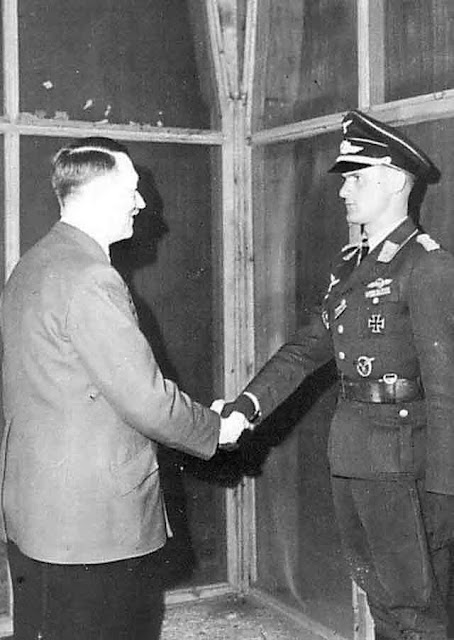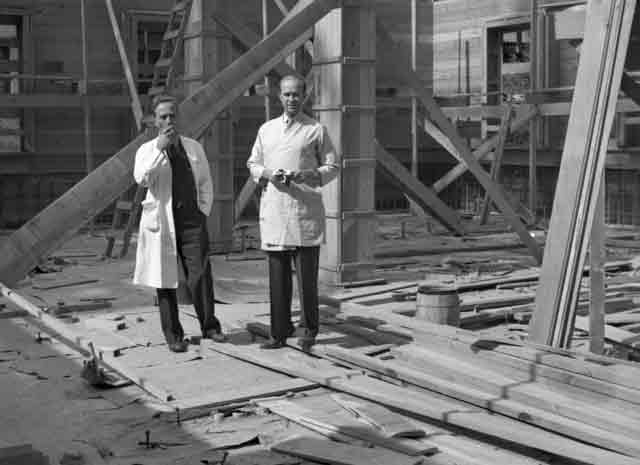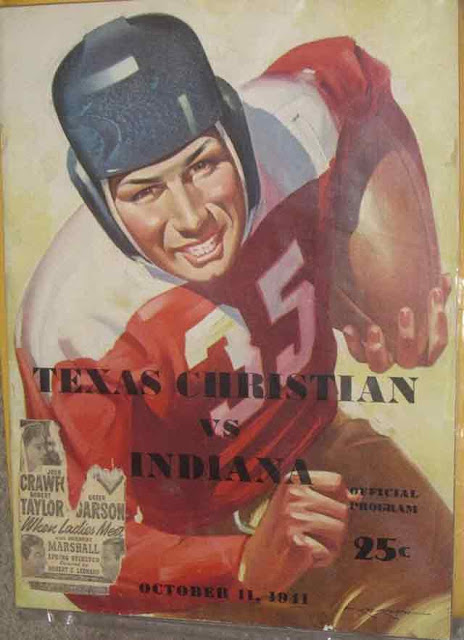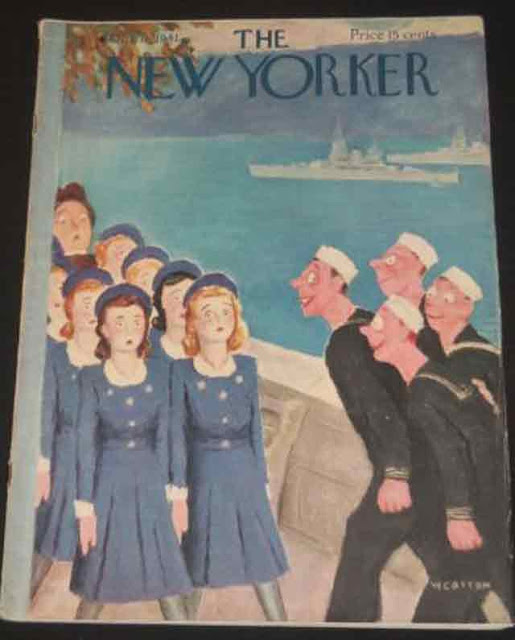Saturday 11 October 1941
 |
| Adolf Hitler decorates Günther Lützow, Kommodore of JG 3, at the Fuhrer Headquarters in East Prussia on 11 October 1941. |
Eastern Front: On 11 October 1941, the Germans are still far down the road from Moscow working on reducing Soviet opposition at Bryansk. However, as described by Russian-born British war correspondent Alexander Werth, who is on the scene in Moscow, a "tank panic" is beginning to grip the city. This is based on wild rumors of panzers on the outskirts of the city. These rumors are fed by a tendency of Soviet news organizations such as TASS to describe the fighting as being "in the direction of" cities that are widely believed to already have fallen. Ordinary citizens begin fleeing to "safe" cities far to the east such as Saratov, and Stalin authorizes the evacuation of non-essential personnel such as women and children who are not engaged in war work.
 |
| Joseph Hamilton (left) and John Lawrence at Medical Physics Building (Donner Lab) construction site [at Berkeley University], taken October 11, 1941. Principal Investigator/Project: Analog Conversion Project. This is a key facility in the development of nuclear weapons in the Manhattan Project. [Photographer: Donald Cooksey] (U.S. National Archives). |
As described by Russian-born British war correspondent Alexander Werth in books such as "Russia at War 1941 to 1945" (London, 1964), who is on the scene in Moscow, there are two main schools of thought regarding whether to stay in Moscow. Those staying feel that those who are leaving are being disloyal in thinking that the Soviet Red Army cannot defend the capital. Those leaving, however, say that they could not bear living under German rule and question the patriotism of those who would willingly risk that. In any event, a flood of people crowds the roads and railways heading east out of harm's way.
 |
| King Haakon of Norway visits Plymouth and the Norwegian Naval Depot and Training Establishment, 11 October 1941 (© IWM (A 5778)). |
General Georgy Zhukov, in charge of Soviet West Front after being recalled from Leningrad, combines his command with General Budenny's Reserve Front to form a united command. He faces a grim situation and orders the trapped Soviet 3rd and 13th Armies at Vyazma to break out. The German cordon around the town is still weak, as the infantry is struggling to keep up with the rapid panzer advance, but already the Wehrmacht is pounding the trapped forces with artillery and Luftwaffe strikes. It is in situations like this when the German Junkers Ju-87 Stuka dive bombers are particularly effective.
 |
| Texas Christian vs. Indiana football program for 11 October 1941. |
After dark, the Red Air Force makes a desperate spoiling attack on Luftwaffe airfields on the northwestern, western, and southwestern approaches to Moscow. Soviet intelligence has learned that the Luftwaffe plans a major attack for the 12th that would target airfields, railroad terminals, logistical facilities, and industrial complexes. The Soviets claim to destroy 500 Luftwaffe aircraft at airfields located at Vitebsk, Smolensk, Orel, Orsha, Siversk, and elsewhere. However, as with many claims by both sides during World War II, this appears to be a wildly inflated number which is not confirmed by Luftwaffe records.
 |
| Star Weekly, a publication of the Toronto Star, 11 October 1941. The lady is wearing a Canadian uniform. |
Overall, despite the Red Air Force attacks, the Luftwaffe has aerial superiority virtually everywhere that they choose to assert it. Major Günther Lützow, Kommodore of JG 3, has 92 victories and receives at the hand of Adolf Hitler at the Wolfsschanze (Wolf's Lair Fuhrer Headquarters) the Knight's Cross of the Iron Cross with Oak Leaves and Swords (
Ritterkreuz des Eisernen Kreuzes mit Eichenlaub under Schwerten). However, as is usually the case, with good news comes bad for the Luftwaffe. Today, 7-victory ace (Experte) Hans Schmeidler of JG 77 is lost in action.
 |
| The New Yorker, 11 October 1941. |
October 1941
October 1, 1941: Germans and Finns Advance in USSR
October 2, 1941: Operation Typhoon Broadens
October 3, 1941: Air Battles Near Moscow
October 4, 1941: Stalin Contemplates Defeat
October 5, 1941: Hoth Goes South
October 6, 1941: First Snowfall After Dark
October 7, 1941: Stalin Gets Religion
October 8, 1941: FDR Promises Stalin Aid
October 9, 1941: FDR Orders Atomic Bomb Research
October 10, 1941: Reichenau's Severity Order
October 11, 1941: Tank Panic in Moscow
October 12, 1941: Spanish Blue Division at the Front
October 13, 1941: Attack on Moscow
October 14, 1941: Germans Take Kalinin
October 15, 1941: Soviets Evacuate Odessa
October 16, 1941: Romanians Occupy Odessa
October 17, 1941: U-568 Torpedoes USS Kearny
October 18, 1941: Tojo Takes Tokyo
October 19, 1941: Germans Take Mozhaysk
October 20, 1941: Germans Attack Toward Tikhvin
October 21, 1941: Rasputitsa Hits Russia
October 22, 1941: Germans Into Moscow's Second Defensive Line
October 23, 1941: The Odessa Massacre
October 24, 1941: Guderian's Desperate Drive North
October 25, 1941: FDR Warns Hitler About Massacres
October 26, 1941: Guderian Drives Toward Tula
October 27, 1941: Manstein Busts Loose
October 28, 1941: Soviet Executions
October 29, 1941: Guderian Reaches Tula
October 30, 1941: Guderian Stopped at Tula
October 31, 1941: USS Reuben James Sunk
2020






No comments:
Post a Comment